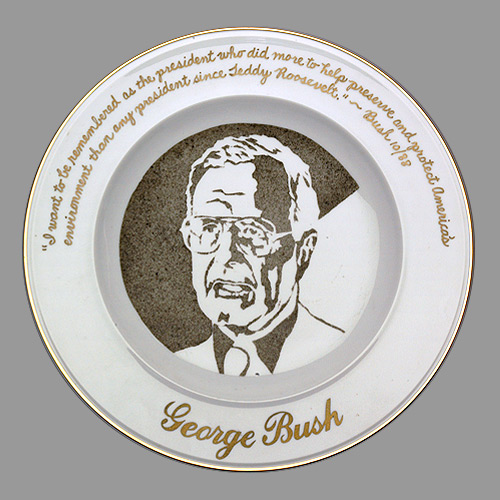Kim Abeles at Art Resources Transfer, Inc – Brief Article
Art in America, April, 2002 by Joe Lewis
Infrequently seen on the East Coast, Kim Abeles is well known and respected on the West for her political and ethnographic art work. This midcareer survey of 57 works in a wide range of mediums included books, constructions, photographs, drawings and paintings from 1979 to 2001. At first sight, the show seemed like a cacophony of different voices, but upon careful inspection, the continuity of her motivation and esthetic became apparent. Content drives form in fresh and witty works that investigate the cultural environment and social psyche.
Abeles often makes multiple pieces on a theme. Charting the Getty Collection (2000) enumerates the works on public display at the Los Angeles-based institution through a roughly 12-foot-long matrix chart. Over 300 art works are distributed among numerous categories, such as jewelry, books, love and women artists. According to this chart, only three female artists are included in the museum’s collection. A related work, Exposed Breasts in the Getty Collection (2000), shows 105 photographs, each a quarter inch square, taken by Abeles of breasts from various paintings and sculpture at the Getty. The ratio of women artists to women’s body parts disturbingly deconstructs our male-dominated culture.
In nine works from 2001, Abeles examines the way that color codes the moral and social positions of Disney characters. Using Venn diagrams and color wheels, Abeles, in some cases, collages printed images of well-known personages–Cruella DeVille, Captain Hook, Tinkerbell–onto the charts and, at other times, isolates the colors of these characters’ signature clothing. Infinite Color Wheel (Good and Evil Disney), 2001, a Venn diagram, assigns colors to four groups: rich, poor, good and evil. Perky pastel colors top the graphic, symbolizing the rich, while the poor are on the bottom, represented by earth tones. These are intersected by good (light) and evil (dark) on the left and right. Intersection of Love and Hate (Disney Color Wheels 1), 2001, is a drawing of a Mobius strip divided into segments like a filmstrip; a character inhabits each segment. In a humorous reversal, Abeles has the “good” ones grimacing and the “evil” ones smiling.
Another amusing piece is Run-off Dolphin Suitcase (1995), a life-size welded wire- frame suitcase in the shape of a dolphin covered in tightly packed bands of plastic straws, bottles, plugs and other solid debris plucked from runoff drains. The satin-lined interior is arranged as a showcase with small found objects secured by clasps. The piece calls attention to the waste and excess of postindustrial society.
The artist is probably best known for her ingenious and provocative works that employ the particulate matter found in smog to create images on porcelain, glass or plastic objects. The series “Presidential Commemorative Smog Plates” (1992) consists of 17 portraits of presidents from McKinley to Bush, Sr. The plates were placed on a roof with stencils covering the positive areas of the portrait. The lengths of time they were left to collect the smog was determined by each president’s attitudes toward industry and the environment. Hand-lettered in gold calligraphy around the edges are related quotes taken from inaugural speeches. In a biting critique of executive policy, Abeles appropriates the commodity souvenir in the truest Franklin Mint tradition.
The sculptural assemblage Calamity Jane and Questions of Truth (1984-85) and its accompanying artist’s book plays off the fact that historical references to women are less likely to be accurate than historical information about men. Seven feet tall, the piece consists of a freestanding rectangular structure with various items attached. Sheer fabric, cut in the shape of a western outfit, moves with the air currents created by viewers. Wooden sticks printed with numerous spellings of the title figure’s name, various birth dates and contradictory personal dispositions are placed in glass bottles that hang from one side of the frame. A briefcase with a photograph of a lie detector is on top. Viewers are given all the references needed to connect the dots themselves.
Dazzling in its diversity of appearance and direction, and grounded in intellectual detail, Abeles’s work stakes out a huge territory, which she manages with seamless democratic authority.
Joe Lewis – “Kim Abeles at Art Resources Transfer, Inc – Brief Article”. Art in America. FindArticles.com.

